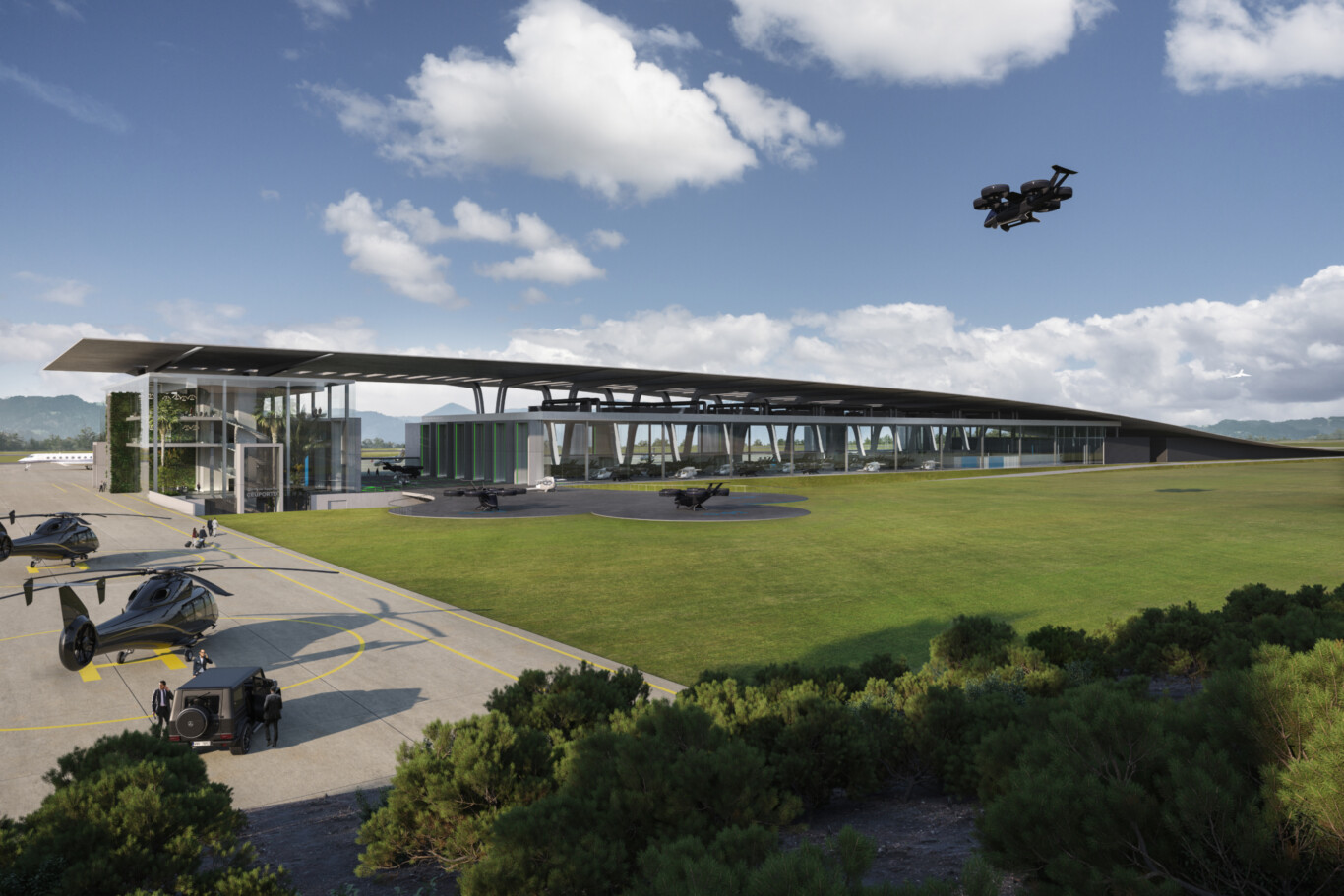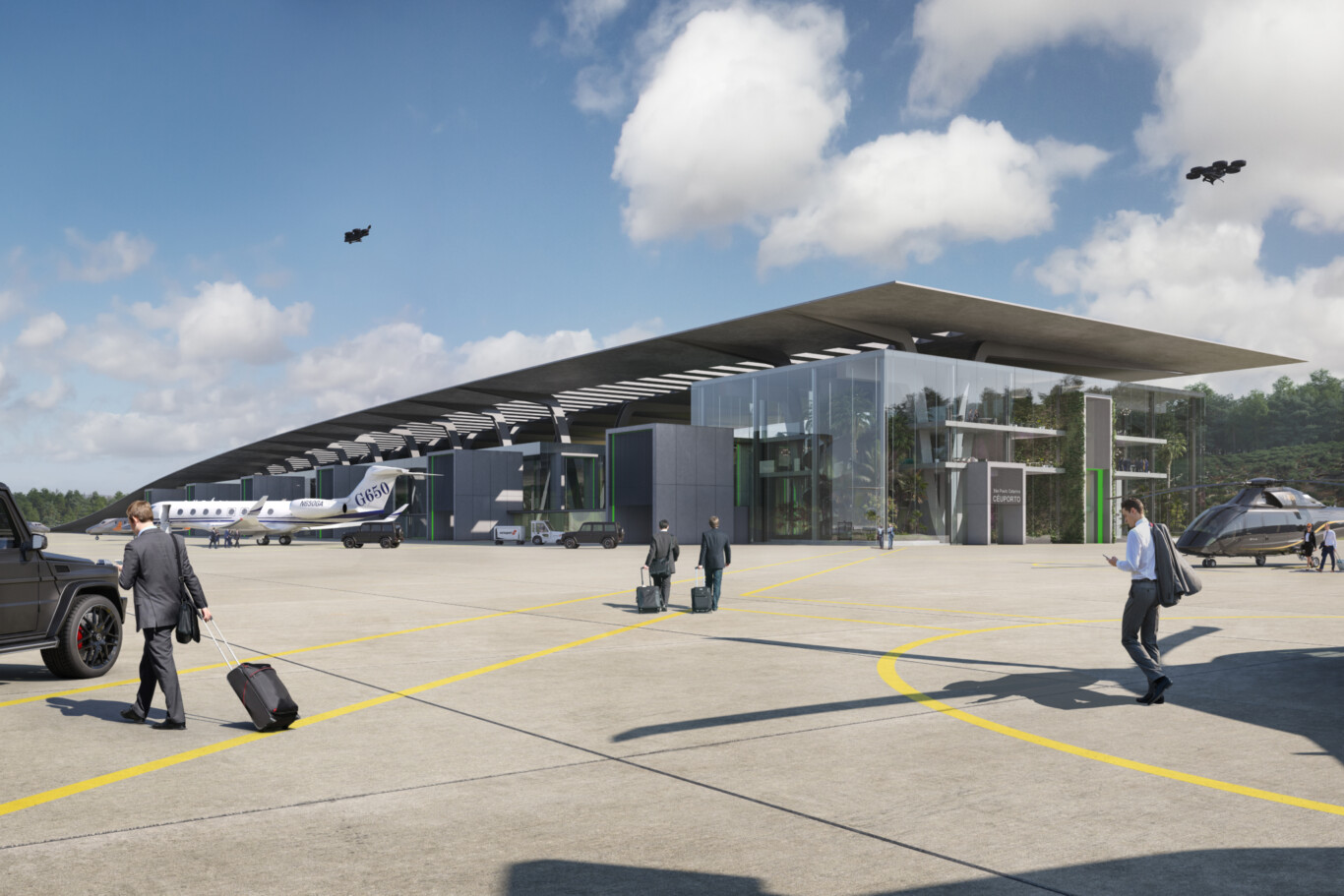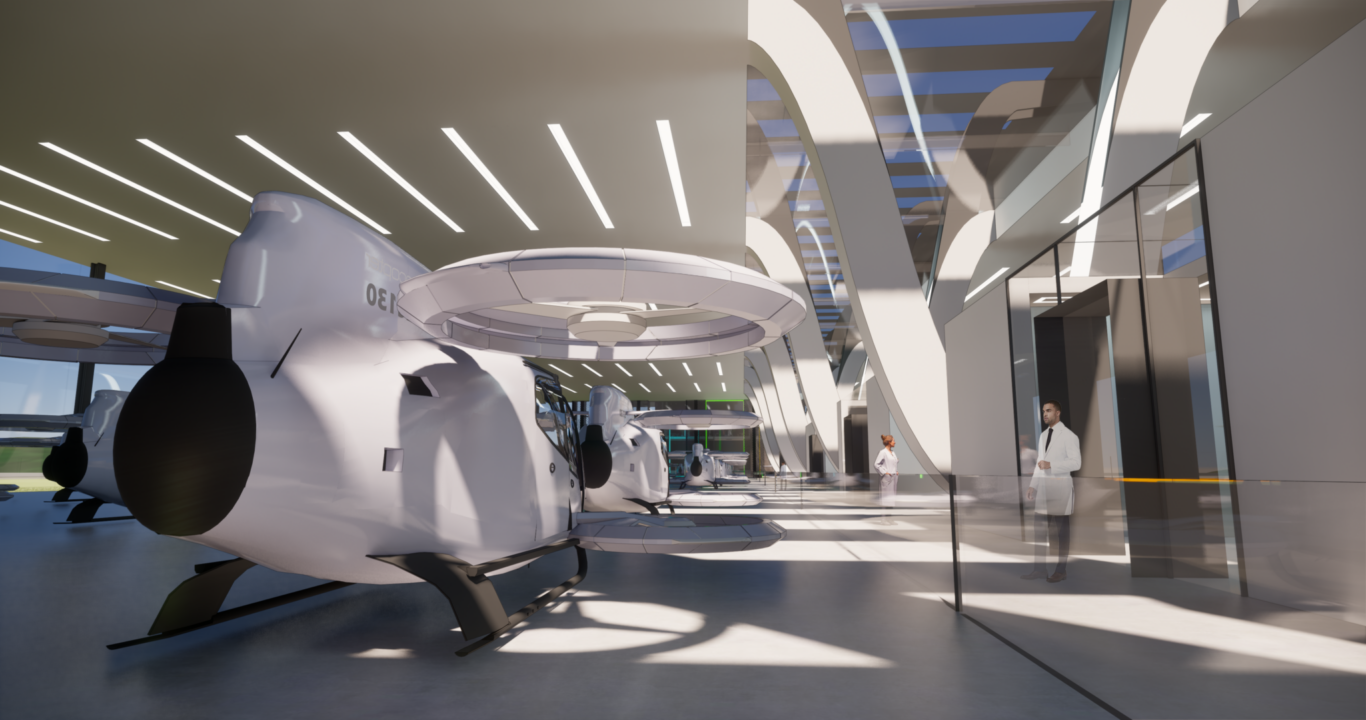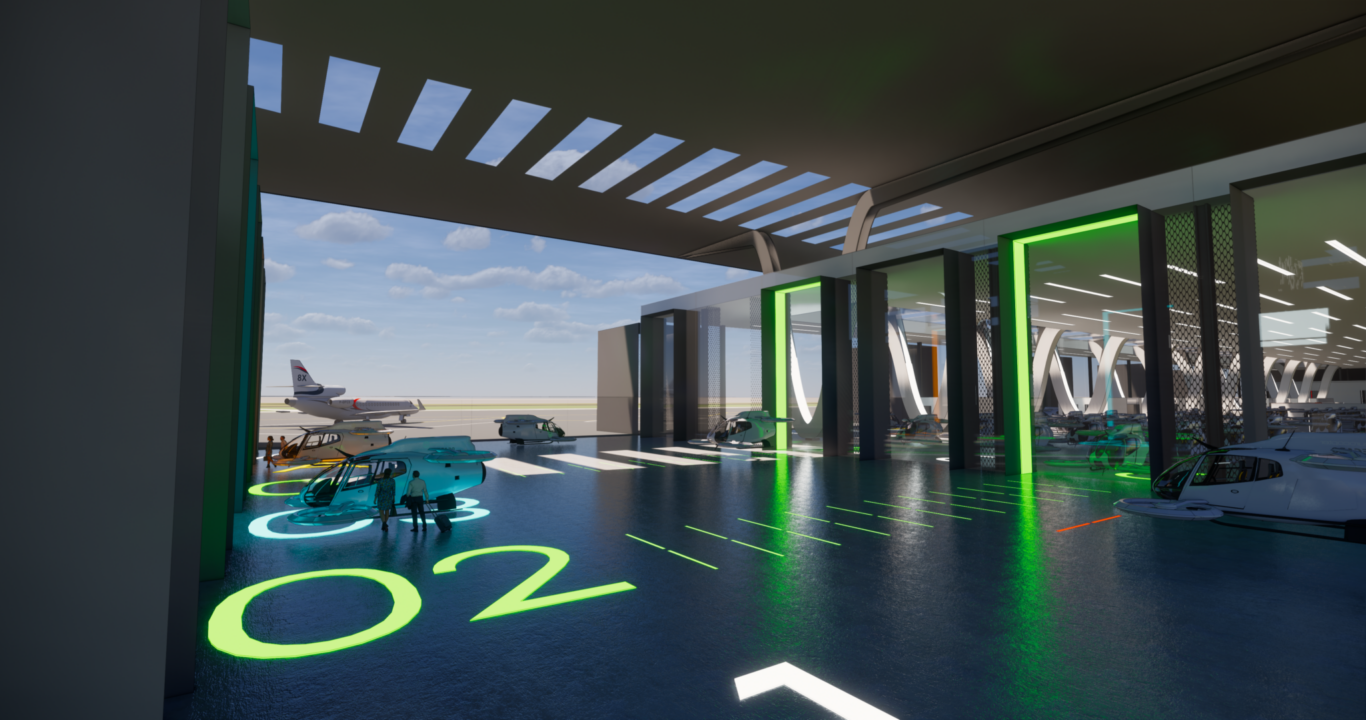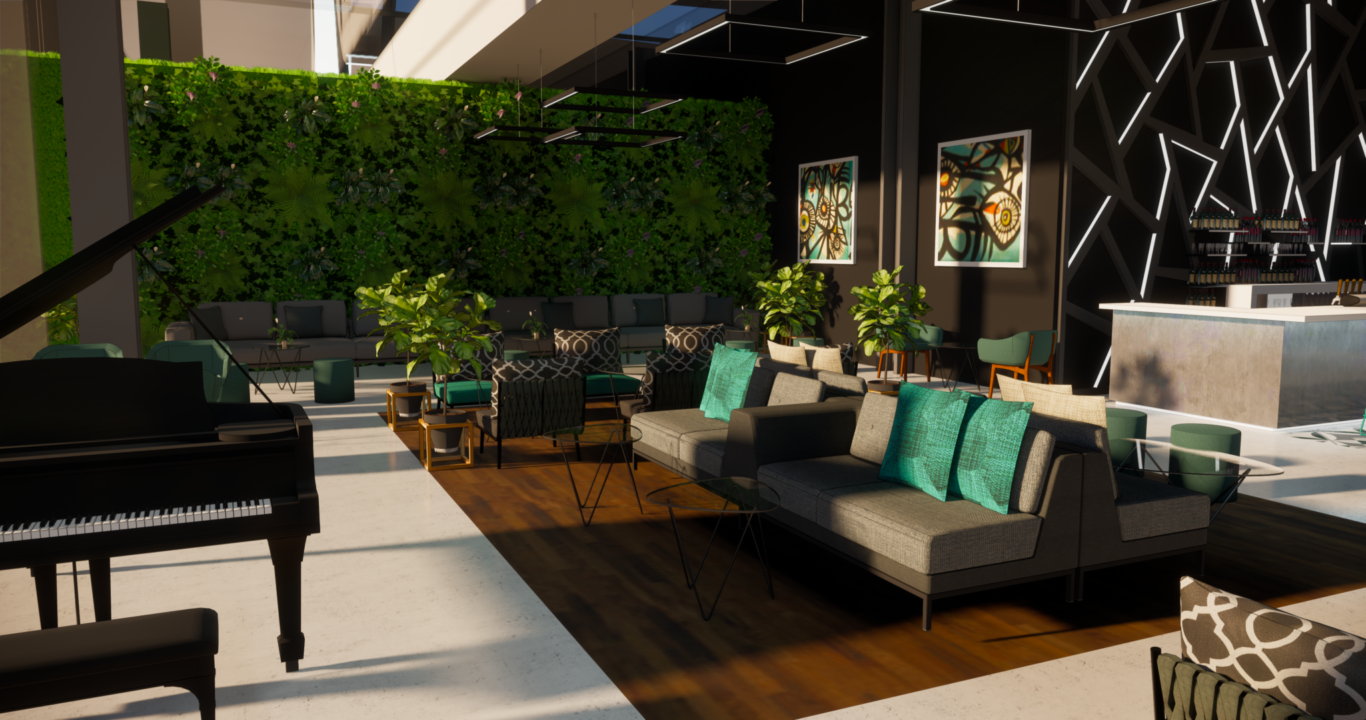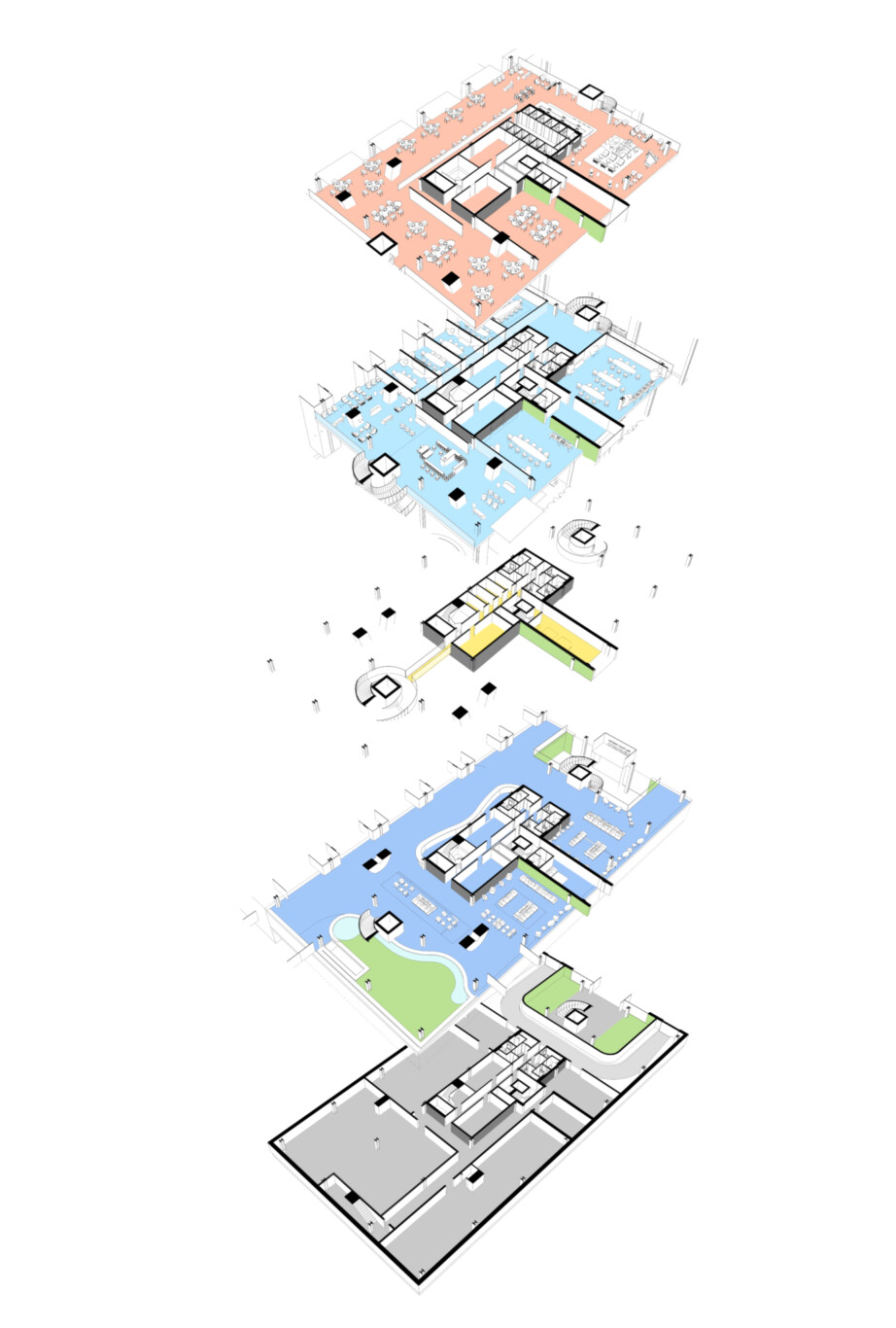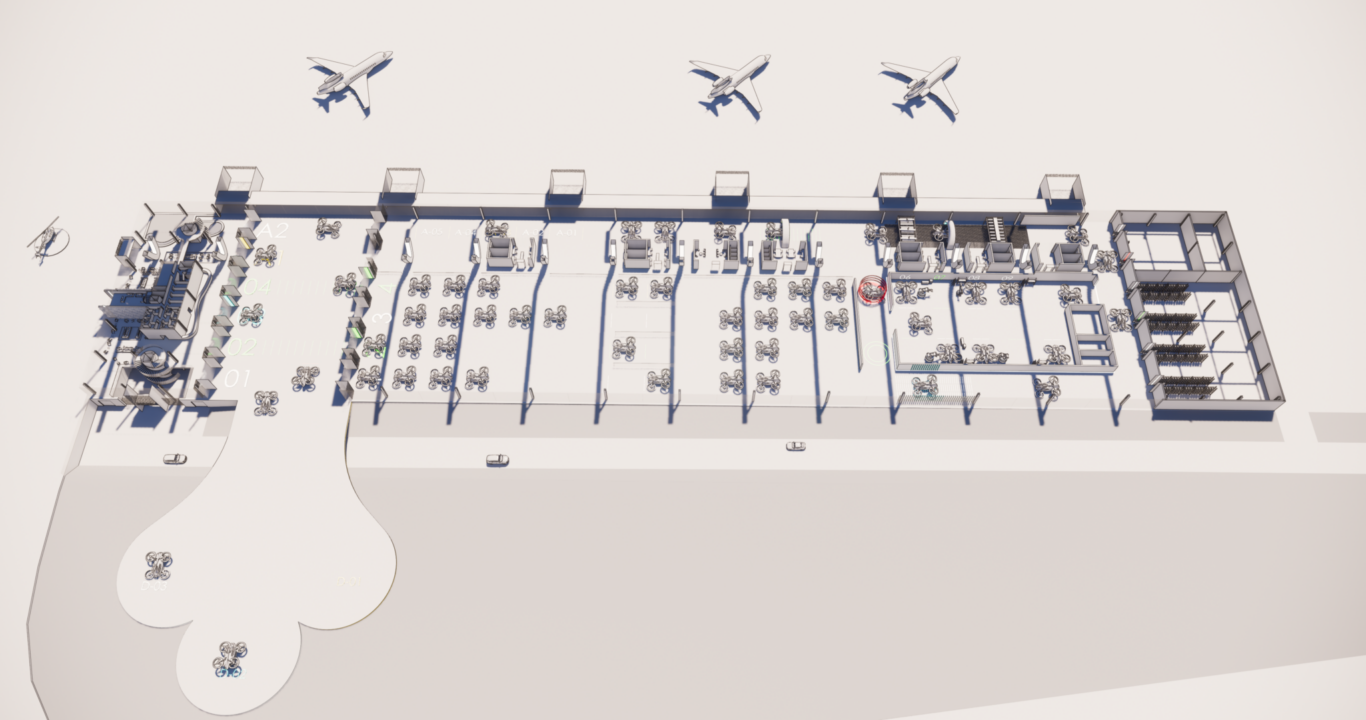
Designing for personal drone vehicle capability for São Paulo, Brazil
Chapman Taylor develops client-specific designs with users at their heart. We research new technologies and thinking to ensure the longevity and sustainability of the buildings we develop. In this Insight paper, Chapman Taylor’s Transport Research Group explores a potential new building type responding to the emergence of eVTOL (Electronic Vertical Take-Off and Landing) technology.
With the kind support of our local partner in São Paulo, we have considered the potential of a development at São Paulo Catarina Executive Airport, GRU Airport and Congonhas Airport, as well as a regional airport at Guaruja, as the basis for our study to demonstrate our ideas about how an eVTOL hub facility may be realised – an expression of purpose through a building that doesn’t feel like a building.
What and Why?
The concept of personalised air travel and the associated vehicles (PAVs) has been around for a long time, depicted in art and design from Leonardo Da Vinci through Fritz Lang’s classic 1927 film Metropolis and Corbusier’s city visions to the present day. Today, however, we are on the brink of seeing the principles behind these visions become reality.
All these early ideas are based on their benefits in congested urban environments. While the dominance of the internal combustion engine is waning, demand for personal ground-level mobility is still there.
Partly due to the urban context, the tendency of these concepts is towards Vertical Take-Off and Landing (VTOL) capability. This classification is broad, encompassing a variety of types of aircraft which includes fixed-wing aircraft, helicopters and others; however, the emerging technologies are based on five broad typologies:
We have already seen the application of this type of technology, with drone vehicles taking to the skies to survey, monitor and deliver. So it is largely a matter of scale and management.
A key driver for these technologies is environmental, with the development of electric and hybrid-electric propulsion – hence the “e” in eVTOL.
While mass ownership of PAVs may be some years away, the potential of air taxis is generating increasing interest and excitement. There are numerous start-ups and established players developing hundreds of eVTOL concepts to enter what is seen as a potentially extremely lucrative market.
These services are being formulated as conventional driver and passenger services as well as advanced drone vehicles facilitated by structured airspace, 5G and the potential for safe and secure data networks.
As technology develops, the prospect of all-electric vehicles, well-suited for short distances at medium speed, becomes more real, promising a great addition to integrated urban transport networks.
Currently and for longer distances, hybrid-electric concepts can provide the necessary range while still offering quieter, environmentally friendly transport.
Context
São Paulo's Rua da Consolação is often congested for hours each day, leading residents and city leaders to wonder if other transport modes can be used to reduce traffic while increasing sustainable mobility.
With around 500 registered helicopters and 700 flights per day, the metropolitan area, with its 20 million inhabitants, has the biggest helicopter fleet in the world. These have become essential to those in the city who can afford them, and to those visiting, to avoid the congestion.
Uber and other providers already operate helicopter taxi services and it will be a small step to an eVTOL service.
The flight from Campo de Marte in northern São Paulo to Guarulhos International Airport can take as little as 10 minutes, costing around 211 reais ($63), plus 30 reais ($9) for the car ride from house to helipad, or about twice what the trip would have cost by cab alone. The same trip in a cab, however, could take an hour, or even two, in rush hour traffic.
The business-focused Catarina Executive Airport, for example, has been developed specifically for executive aviation, mostly serving existing executive aircraft on long-haul international flights. It has been designed to link with São Paulo via road and helicopter, as well as by potentially emerging modes such as eVTOL.
Connectivity
Upon introduction, the service will focus on a route from the airport to city destinations, using the many rooftop landing opportunities that already exist in São Paulo along with adaptable potential sites, such as multi-level car park structures. In time, the hub base will be augmented by the connection of these point to point locations, supporting a wider city connection.
The vehicles themselves will be limited by their battery charge capacities and therefore we need to establish charging stations at key locations in partnership with building owners. There is also scope for individuals or small parties to share vehicles with others where their destinations coincide.
Concept
The design focuses on operational flow as well as a desire to develop transparency so that customers can see the process of managing and moving the vehicles through the facility.
Vertical planes are more transparent or translucent than solid, exposing most of the internal workings of the facility. It touches the ground so delicately that landing can be almost imperceptible. The defining element is the curving, strong and protective floating roof, which allows clear comprehension and unimpeded flows and processes.
The plan comprises two main components. The first, the body, consists of the main single vehicle management hall and the second, the head, is the customer services and facility management module. Sitting between the two primary elements is the passenger embarkation and disembarkation atrium; a series of take-off and landing pans extend from the atrium, with eVTOLs marshalled to and from these pad by remote-controlled tugs. The two solid elements within the main hall are the battery charging area and the level B maintenance workshop.
Aircraft maintenance has been classified at three levels. Level A is for day-to-day care such as cleaning and battery changing; level B is for more intrusive maintenance that can be performed on site but should not be viewed by costumers; level C is where maintenance needs to be performed off site.
A series of standalone accommodation pods hosts facilities for staff within the main hall. A corridor runs along the northern side of the main hall, providing sheltered access to a number of conventional aircraft stands.
The final, and key, element is the technical operations block that sits below the springing end of the roof. This element is solid, reflecting its secure nature the housing for airspace and drone management systems.
The facility management module is formed as a single crystal, within which sits a dark solid core connected to the outside face of the crystal by a single “green thread”.
The management module comprises five levels and includes the customer reception and management operations, lounges, meeting rooms and some catering amenities, management offices and welfare areas.
The solar-controlled, triple-glazed walls contain an integral mesh that protects the building from any adverse effects from low-level sunlight as well as adding a diaphanous quality to the walls. In some areas, integral blinds and electric activated smart glass. The thickness and spacing of the glazing pains provides the necessary acoustic properties.
The mass concrete roof and floor construction is designed to absorb and store heat, providing "inertia" against temperature fluctuations. When outside temperatures are fluctuating throughout the day, the mass serves to help "flatten out" these fluctuations, since the thermal mass absorbs thermal energy when the surroundings are higher in temperature than the mass. It can then release that stored thermal energy when the surroundings are cooler.
Rather than being hidden away, the main facility MEP plant is located on a dedicated platform protected by the roof sitting above the main hall. This allows maximum access and flexibility for these services.
Passenger Process
While our design focus is on eVTOL traffic, we have built in the maximum practical flexibility to allow passengers to switch easily between travel modes. Passengers can arrive and leave by eVTOL, conventional fixed wing and rotary aircraft and private cars.
The private car reception area is located at Level -1 with the main passenger management zone, reception and short stay lounge on Level 0. At the appropriate time, a taxi is brought to one of six parking bays for passengers to embark. The vehicle is then moved to an available pad. The arrival experience operates in reverse.
We anticipate being able to accommodate a potential peak number of 40-plus movements an hour, and potentially more, depending upon the pads operating simultaneously.
eVTOL process
The eVTOL processing happens mainly within the vehicle management hall. The process is best explained by examining what will happen upon the arrival of an inbound aircraft.
After landing, the vehicle taxis to the embarkation / disembarkation atrium. The passengers disembark and the vehicle is coupled to an automated production line, proceeding through a series of checks, including visual condition, systems and full operation diagnostics. If an issue is raised, the vehicle is shifted to the maintenance engineering area for full investigation. Upon passing diagnostics, the vehicle is cleaned and minor repairs performed, such as wiper replacement, water and oil level checks etc. The battery is uncoupled and sent for testing and charging and a new, fully charged battery is coupled.
Outbound aircraft checks begin with a diagnostic recheck (and movement to the engineering area, should there be an issue). The vehicle is then place in Hangar 1 prior to outbound visual checks, moving to Hangar 2 for customer allocation and departure.
Facility management model
The “head” of the facility is arranged over five levels, with the lower two being mainly focused on the core process of facilitating movement through the facility.
The mezzanine and two upper levels provide added, targeted services, enhancing customer experience.
The solid core houses the necessary back-of-house operations, toilets, welfare and some discreet functions.
The green thread provides seclusion for VIP customers, while the rest of the crystal is more open and outward looking.
The look and feel of the customer areas is that of modern, sumptuous luxury and personal service.
Vehicle management hall
The components of the eVTOL management hall are purely functional in nature. They are arranged to provide a simple and efficient operational flow.
The aesthetic is that of a clean, uncluttered room, helping to emphasise the quality assurance standards of the service provider.
Much of this groundbreaking process is visible to the customer, reinforcing confidence through transparency. More intrusive maintenance functions are veiled to avoid any unnecessary anxiety.
Level -1 – Basement, service and road access
The lower level has been built in to the ground to provide secure and discreet road access and to accommodate a large amount of back-of-house (BoH) accommodation, including storage, some plant services, staff accommodation and the catering kitchens.
The kitchen are linked to all levels by a dedicated core and lift to a forward service facility on each level. This way, the one kitchen can service all facilities and provide responsive and bespoke, client-focused service efficiently.
It is at this level that we first encounter the ‘green thread’ linking all levels of the crystal and solid core, providing discreet access by VIP customers.
Level 0 – Reception
The two-level reception area is dominated by a large reception desk wrapping around one side of the central block. The principle of the facility is that customers should have to wait for as little time as possible.
However, much of level 0 is given over to short-term lounge space to provide relaxation before or after eVTOL or conventional aircraft departure. Space allowances are generous to provide comfort and privacy in an open-plan lounge.
The lounge areas are connected to catering facilities below to provide beverage and snack services.
An area of internal soft landscaping with a water feature provides natural respite and coolness to the lounge area.
Mezzanine – Spa, sleeping pods and lounges
The mezzanine of the solid core provides special facilities for customers who wish to dwell there while either waiting for onward travel, such as pilots waiting for their passengers, or while their party conducts business.
The level also provide a pilot office for the purposes of arranging fuelling and maintenance and planning and logging flight plans.
Facilities include a spa, VVIP lounge and sleep pods for pilots.
Level 02 – Business facilities
This level is conceived as a flexible business facility with flexible meeting rooms, breakout spaces and informal lounge areas. All areas carry the latest business support and communication technology. These facilities will allow customers to make use of any dwell time, to conduct additional meetings or to conduct business without the need to travel into São Paulo city.
The ‘green thread’ continues through this level, with facilities that can be closed off for the exclusive use of these customers.
Level 03 – Restaurant, bar and lounge
The top level of the crystal provides a bar, a restaurant and private dining facilities, all managed and served from the core. The ‘green thread’ links to a secure private dining suite.
The views from this level offer a panoramic vista across the region, including towards the city of São Paulo.
Customers can dine alone, discreetly, in parties from two to 80, or avail of a more vibrant walk-in service. The food and beverages offered include local, healthy and sustainable produce.
Sustainability
The eVTOL revolution is partly inspired by the desire for a more sustainable form of travel, using less energy and making journey times more efficient.
eVTOLs are very efficient when cruising, but take-off and climb modes can consume substantial amounts of power. Therefore, journeys need to be longer to be practical and take-off/landing need to be efficient, with minimised holding.
According to the University of Michigan[i], eVTOLs give off 28% more greenhouse gas emissions than battery-electric road vehicles (BEVs) making the same 100km journey, although they give off 35% lower emissions than internal combustion road vehicles – the slow-moving traffic at street level is likely to more than account for the difference.
Also, when comparing a “fully loaded (e)VTOL” (estimated at three passengers) with an average car occupancy of 1.54, (e)VTOL greenhouse gas emissions are 52% lower than internal combustion vehicles and 6% lower than battery-powered cars.
Additionally, passengers may be more inclined to take an eVTOL due to the time savings, making it easier to fill eVTOL air-taxi flights. Ride-sharing in cars will generally result in further travel time, as seen with car-hailing services such as Uber Pool – adding both the vehicle’s greenhouse emissions and the distance travelled.
The proposed facility also includes many proven features to reduce the environmental impact of the building and operation, including:
- Photovoltaic arrays
- Rainwater collected from the roof and stored at its base
- Greywater harvesting
- Thermal mass heat energy storage
- High-specification thermal performance materials
- Ground-source heating
- Natural cross-flow ventilation and cooling
This work is the product of cross-discipline collaboration between the Chapman Taylor Transportation team’s members and experts from across the company, as well as the kind assistance of our clients and other consultants.
[i] ‘Role of flying cars in sustainable mobility’ The University of Michigan and car manufacturer Ford
